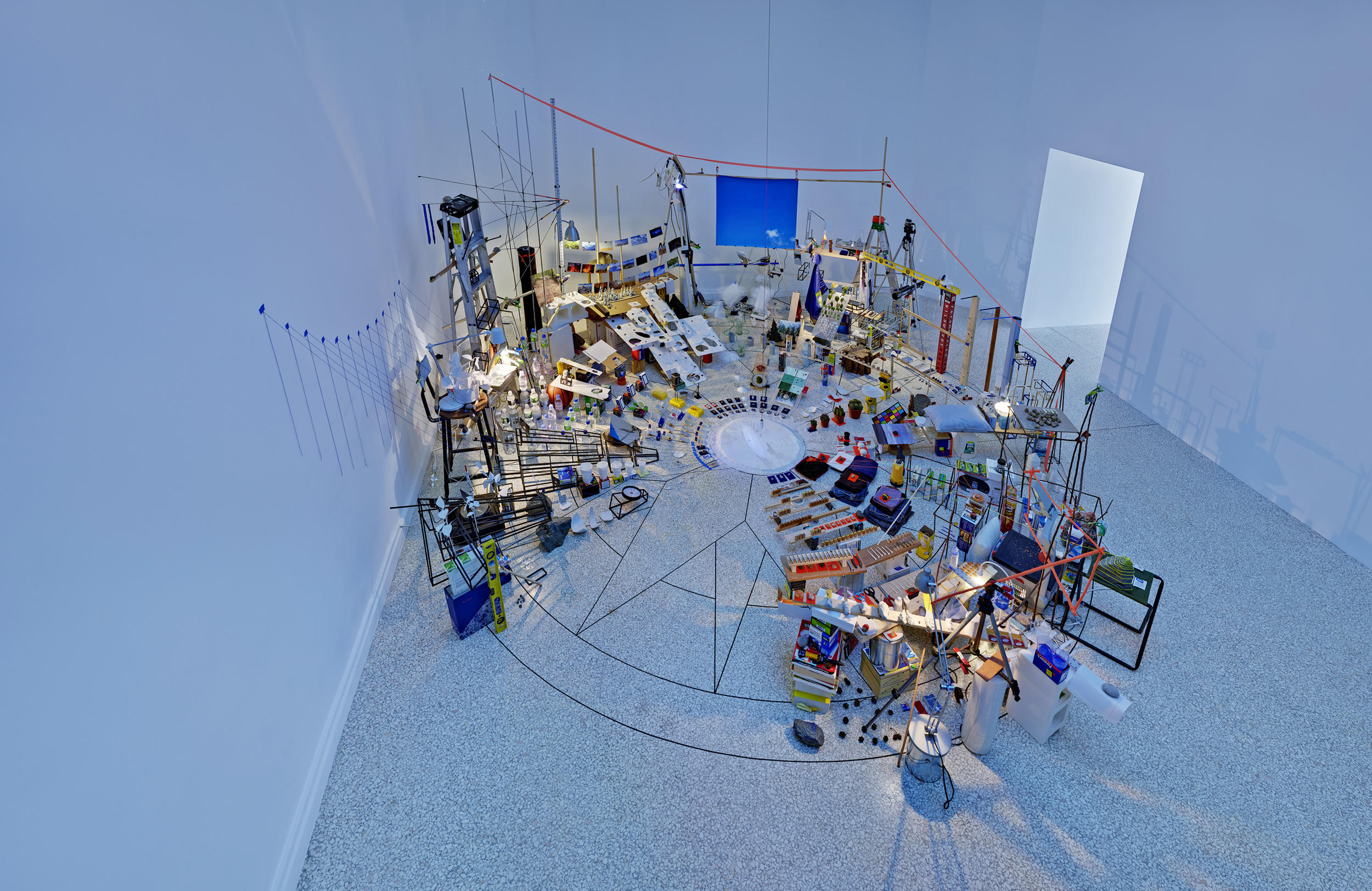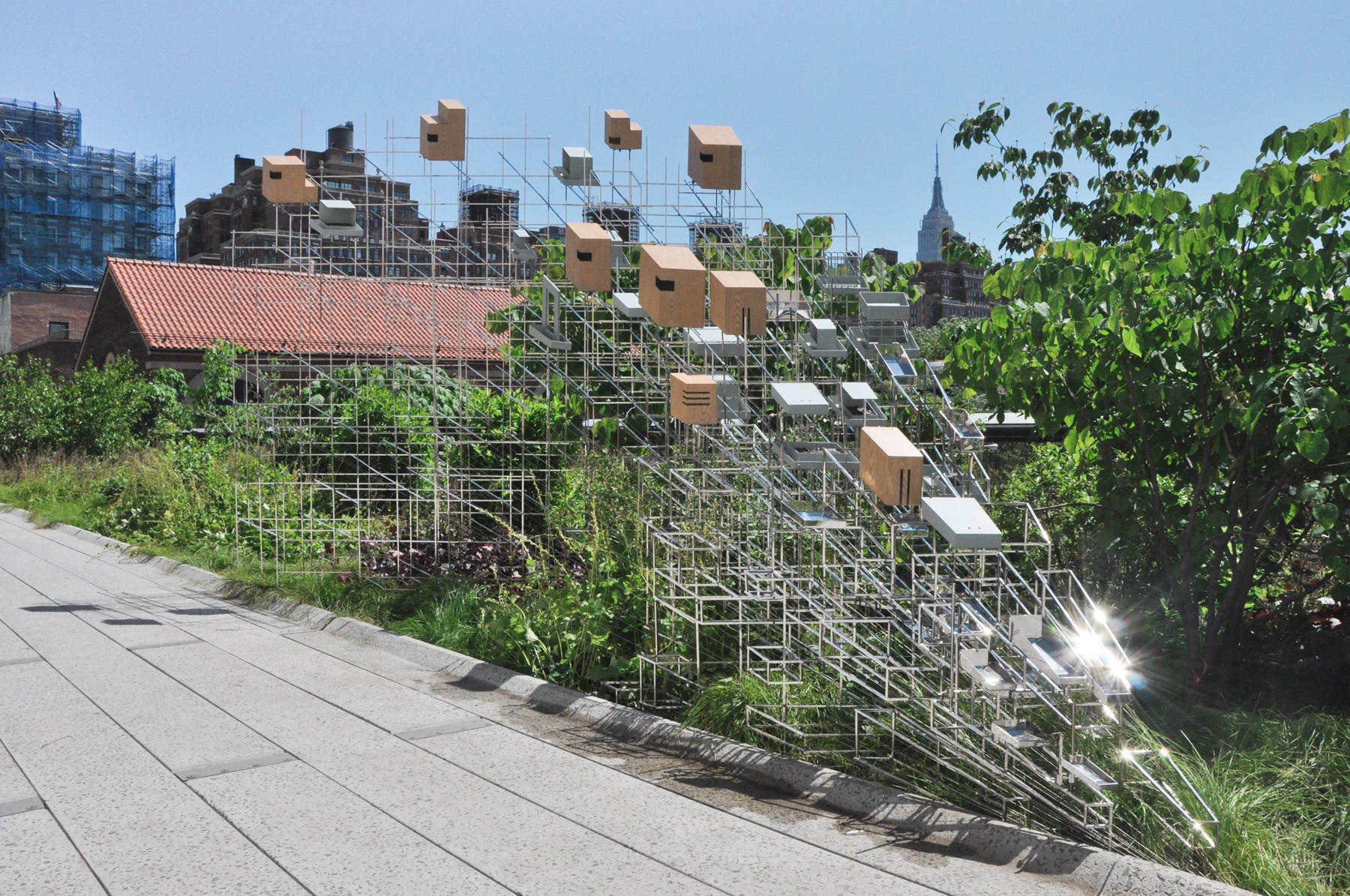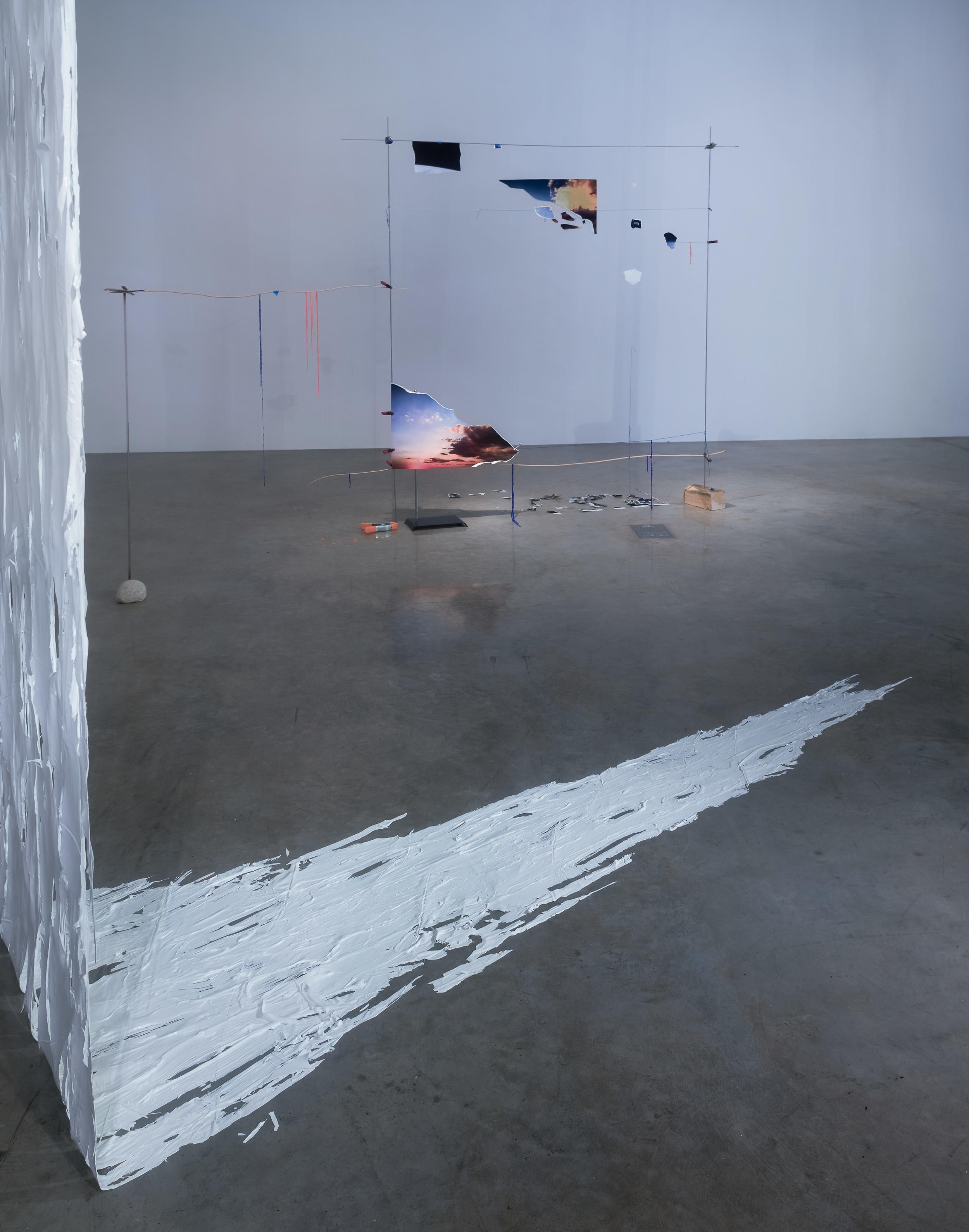
You go to Sarah Sze’s studio in Midtown Manhattan, not really knowing what to expect. Maybe you’ve seen her work — her installation Still Life with Landscape (Model for a Habitat), a bird-and-butterfly sanctuary of steel framework and wooden boxes, was perched on the High Line for a year starting in June 2011. Five years earlier, Corner Plot, in which a single corner of bricks and windows jutted from the pavement, suggesting a sunken apartment building, attracted passersby at Fifth Avenue and 60th Street. Or maybe you were at a party recently and saw, on a coffee table, Sze’s new monograph, with its cover image of 360 (Portable Planetarium). That sculpture, a skeletal sphere of fragile, possibly rickety construction, is crossed with radiating strings and spindly scaffolding, slung with random objects, and pierced with light — a cosmic meditation.
Or maybe you’ve never seen Sze’s work, and are more aware of her reputation. She received a 2003 MacArthur foundation “genius grant” and was the US representative to the 2013 Art Biennale in Venice. The sublimities of her art led the late Columbia philosopher and art critic Arthur Danto ’52GSAS, ’04HON to write that her concern as an artist is “to feel her way into the future, into art that had yet to be imagined.” And the sculptor Richard Serra told the New Yorker that Sze “is changing the potential of sculpture.”
Ascending the elevator to Sze’s workshop, you realize you’re still holding a cup of coffee. With a chill you ponder what Sze (pronounced Zee) will make of your bringing a spillable liquid to her studio door. Of course you will apologetically surrender it before entering. And, reflecting on Sze’s use of everyday items in her work — light bulbs, Q-Tips, cereal, lamps, aspirin, fans, plastic flowers, plastic spoons, electric lights, socks, notepads, candies, thimbles, milk cartons, disco balls, toilet paper, and yes, coffee cups — you muse that maybe she’ll end up incorporating it ... until you remember that Sze doesn’t use trash in her work. That’s because trash has a past: she uses the unused, the fresh-bought, things without history or nostalgia; the object as tabula rasa.
The elevator opens and you step into a large, sunny loft, where Sze, forty-seven, warmly welcomes you. Dressed in black, her dark hair coiled in a bun, she imparts the easy self-possession of someone in pure synchronicity with the ticktock of creative life. She assures you that your coffee cup is no problem, and lets you set it on one of the worktables, which is covered with color photos from magazines. On the floor, lunchbox-sized blocks of clay have been cut into thick slices, and the walls are plastered with pictures that feed Sze’s current interests: fourteenth-century step wells in Delhi; a rock formation in Northern Ireland of basalt columns, shaped over millions of years; a Japanese print in which the white of the paper is articulated into a snowy field by spare strokes of blue.
Sze is a seeker and processor of data, a metaphysical alchemist, mining magical effects from the inanimate, the mundane. Her canvas is time and space, her work a discourse with the physical world, an elaborate dance with instability and demise. “That we question permanence when we see a work is very important to me,” she says. Because her work is often site-specific and imbued with spontaneity, it is impossible to duplicate: the works are sculptural accounts of ephemerality itself, with objects rambling, colonizing, and dispersing at once, suggesting a volatile state of being made or unmade, of growth or decay. Within all this lies the question of how objects acquire value, and the ways in which arranging common items outside their usual contexts can change their meaning.
“How do we create value in an object?” Sze says. “Objects are less valuable than life, because life ends, so the idea was to make work that felt like it had a life to it, and had a life-support system that must be cared for; that gave a sense that if you left it and came back in an hour, it might be different; that it won’t ever exist elsewhere, and that this exact experience won’t exist again.”
Sze was born in Boston in 1969. Her father, whose family had come to the US from China when he was four, was an architect, and the house was like an extension of his office, with drawings everywhere. Her mother taught nursery school, and come vacations she’d bring home the class pets, so that Sze and her brother grew up with a turtle and a bird (“Our house was very animated,” Sze says). The family shared a love of art, music, and dance, and Sze discovered early on that creativity was a way to grasp the world and communicate with it. “I made art all the time, drawing and painting and making things,” she says. “It was definitely where I found joy.”
She studied painting and architecture at Yale and later switched to sculpture, making her first splash in 1996 at a show in New York. There, she covered the surfaces of a narrow storeroom space in SoHo with hundreds of figurines made from single squares of toilet paper. She came to Columbia’s School of the Arts to teach in 2002 and was made a full professor in 2009. She lives downtown with her husband, Siddhartha Mukherjee, a Columbia oncologist and assistant professor of medicine, and the author of the Pulitzer Prize–winning The Emperor of All Maladies. They have two young daughters.
Sze teaches in the spring, and she administers the same care to her students that she does to her art. For graduate critiques, she’ll go into the artist’s studio and look at the work in silence, thinking about what needs to be said and how to say it. “I emphasize information over affirmation,” she says. “I want to give people tools to think about what they’re doing. My goal is that when I leave the studio, the artist wants to dive into the work.” For group classes, it’s the same: “We don’t talk about liking or not liking something. It’s not about taste. It’s about allowing the person being critiqued to learn about his or her process without feeling debilitated.”
Art school, says Sze, should be a place where you can make mistakes and get feedback. “You can create this incredible dialogue, which can accelerate the work so quickly,” Sze says. “It’s such a miracle when you see someone’s work develop in two years, which is nothing — that’s why I love teaching the Columbia MFA students: they’re so wonderful, thoughtful, intense, and committed.”
Sze enjoys her undergrads, too. “They are super smart and totally open creatively,” she says. “There’s this willingness to learn, and a joy in exploration. I love the dialogue. I learn so much from them. I love going up there. Every time I leave, I’m totally energized.”
At the back of Sze’s studio is a sliding door: Sze opens it and steps into a dark room. In the middle of the room is a thing, a structure, the sort of eccentric, spectacular creation that only genius could produce. It’s humming and blinking, and your first thought is: it’s alive. You move toward its glow, around its curvature, pulled by a shuddering sense of revelation.
Now it appears: a crystal city of information, of mirror shards and torn photographs and desk lamps and assorted fragments, the galaxy of it caught in a fragile and complex anatomy. Sze points out the two worktables that form the base of the opus, obscured in a jumble of objects that has proliferated from the site of its making with an almost biological compulsion. Video screens ripple with oceans and fires before pixelating, disintegrating; while on the ceiling there plays a fuzzy, flickering light, cast there by the collusion of a tray of water, a fan, and a mirror, and suggestive of film. Sze has been thinking about the origins of film, and “how film marks time, how it feels in the memory.”
It’s a lot to take in — which is part of the point.
“I’m playing with this idea of this onslaught of images, and images as debris, juxtaposed in ways that you don’t imagine,” Sze says. “Though it can be overwhelming, we’ve been conditioned to learn how to read this much information at once.” You then notice animals on the walls, circling the room at varying speeds: a peregrine falcon, followed by a cheetah and other creatures. The images are beamed from a rotating projector within the sculpture, in plain view (Sze hides nothing: the curtain is always pulled back). The swirling projection, Sze says, “makes the architecture become this cocoon that encircles you.” You are in the sculpture, and perhaps have become its plaything.
“I want the feeling that you are having a moment in time that is fragile and you’re experiencing it live,” Sze says. “Very few moments are marked in time anymore, because we can now access so many things out of time. It’s about the moment of being there.”
So you stand at this altar of ingenuity, delicacy, intricacy, craft, caprice, ideas; this fragile ecosystem, this cracked mirror of civilization. Its title is Timekeeper. It took six months to complete, and, like much of Sze’s work, it will be dismantled.
Nothing lasts forever, but some things last longer than others. This winter, the long-awaited, long-delayed Second Avenue subway line is scheduled to open with three stations. In a bold scheme, the MTA handed each station to a single artist — 72nd Street to Vik Muniz, 86th to Chuck Close, and 96th to Sze — a canvas as big and public and challenging as one could dream of, and, in some ways, says Sze, “as permanent as you can get.”
The station at 96th Street is two blocks long, with three entryways. Sze has anointed it with vast violet-blue drawings that she fabricated in porcelain-enamel panels. “It’s all based on the idea of blueprints, of drawing as a tool to understand three-dimensional space,” she says. As ever, Sze brings an architect’s concern for the viewer’s experience of encountering the art — how one enters and leaves, how things unfold. “When you go into the station, it’s an entirely immersive environment," she says. "You experience it coming down." She points to a picture of the steep gradient of the escalator, with its blue wall and fine white lines and ripples and marine-like shapes. “You’re in this narrow space on the escalator. You’re in a void, and then you get this intense vertical landscape.”
Another picture shows the wall above the track bed, the part that’s still visible when a train pulls in. It bears Sze’s arresting abstractions in blue and white, a distinctive signpost for the weary straphanger. “When you come to that station,” Sze says with a laugh, “you’ll know exactly where you are.”
All photos of artwork courtesy of the artist and Tanya Bonakdar Gallery, New York.





